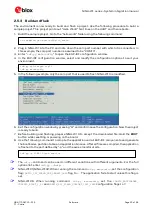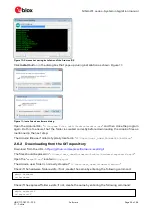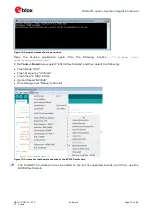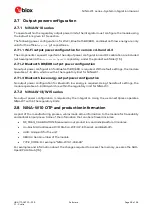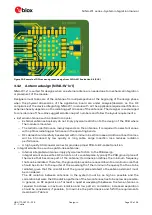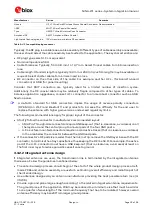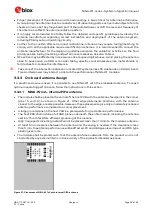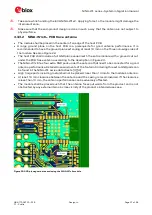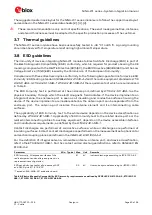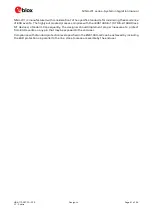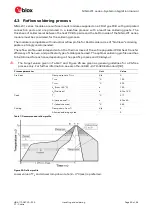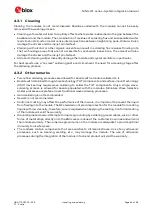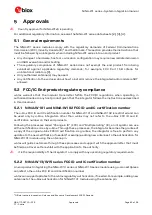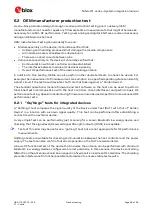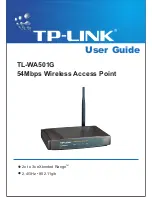
NINA-W1 series - System integration manual
UBX-17005730 - R15
Design-in
Page 34 of 54
C1 - Public
As a numerical example, the physical restriction to the PCB design can be considered as shown
below:
Frequency = 2.4 GHz
Wavelength = 12.5 cm
Quarter wavelength = 3.125 cm
o
Radiation performance depends on the whole product and antenna system design, including
product mechanical design and usage. Antennas should be selected with optimal radiating
performance in the operating bands according to the mechanical specifications of the PCB and
the whole product.
Table 4 summarizes the requirements for the antenna RF interface:
Item
Requirements
Remarks
Impedance
50
Ω
nominal characteristic
impedance
The impedance of the antenna RF connection must match
the 50
Ω
impedance of the
ANT
pin.
Frequency Range
2400 - 2500 MHz
Wi-Fi and Bluetooth.
Return Loss
S
11
< -10 dB (VSWR < 2:1)
recommended
S
11
< -6 dB (VSWR < 3:1) acceptable
The Return loss or the S
11
, as the VSWR, refers to the
amount of reflected power, measuring how well the primary
antenna RF connection matches the 50
Ω
characteristic
impedance of the
ANT
pin.
The impedance of the antenna termination must match as
much as possible the 50
Ω
nominal impedance of the
ANT
pin over the operating frequency range, thus maximizing
the amount of the power transferred to the antenna.
Efficiency
> -1.5 dB ( > 70% ) recommended
> -3.0 dB ( > 50% ) acceptable
The radiation efficiency is the ratio of the radiated power to
the power delivered to the antenna input; the efficiency is a
measure of how well an antenna receives or transmits.
Maximum Gain
Refer to Data sheet
The maximum antenna gain must not exceed the value
specified in type approval documentation to comply with
the radiation exposure limits specified by regulatory
agencies.
Table 4: Summary of antenna interface (ANT) requirements for NINA-W1x1
Observe the following recommendations while selecting external or internal antennas:
•
Select antennas that provide optimal return loss (or VSWR) figure over all the operating
frequencies.
•
Select antennas that provide optimal efficiency figure over all the operating frequencies.
•
Select antennas that provide appropriate gain figure (that is, combined antenna directivity and
efficiency figure) so that the electromagnetic field radiation intensity does not exceed the
regulatory limits specified in some countries (for example, by FCC in the United States).
3.3.2.1
RF Connector Design
If an external antenna is required, the designer should consider using a proper RF connector. It is the
responsibility of the designer to verify the compatibility between plugs and receptacles used in the
design.
Table 5 suggests several RF connector plugs that can be used by the designers to connect RF coaxial
cables based on the declaration of the respective manufacturers. The Hirose U.FL-R-SMT RF
receptacles (or similar parts) require a suitable mated RF plug from the same connector series. Due
to wide usage of this connector, several manufacturers offer compatible equivalents.
1
Wavelength referred to a signal propagating over the air.




